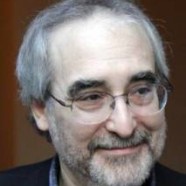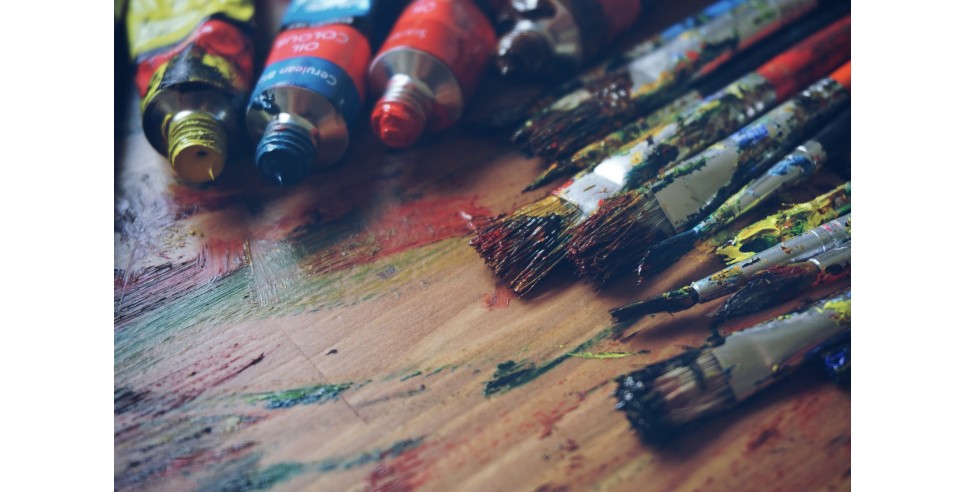
Where there is opportunity, there is art. Art is an expression of the day, of history, of common occurrence and of creative expression. Computers and Digital capabilities enabled the emergence of Digital Art.
Wikipedia’s definition of Digital Art:
|
Digital art is an artistic work or practice that uses digital technology as an essential part of the creative or presentation process. Since the 1970s, various names have been used to describe the process, including computer art and multimedia art. |
Some art and artists have an extremely structural, almost mathematical approach, to their work. In some cases this is considered Modern Art, in others Experimental, Conceptual, Abstract, or Scientific Art.
Mathematics and the graphic arts have enjoyed a symbiotic relationship for as long as there has been art and artists. Symmetry and perspective are the very first interrelated facets of art and math, but there are more. Think of M.C.Escher’s famous 1953 painting, Relativity.
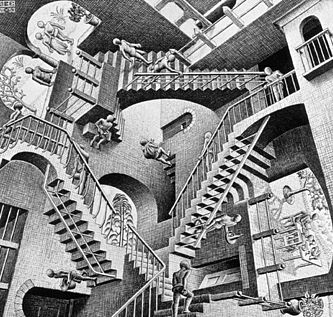
This is creativity, math, absurdity, and extreme attention to fine detail. The painting has elements of geometry, and what was later known in the 1960s as OpArt. It has tessellation. Tessellation is the arrangement of shapes closely fitted together, especially of polygons, in a repeated pattern without gaps or overlapping. On a flat surface it is the tiling of a plane using one or more geometric shapes, called tiles, with no overlaps and no gaps. In mathematics, tessellations can be generalized to higher dimensions and a variety of geometries. A periodic tiling has a repeating pattern.
And Escher did this in 1953 without a computer! He had a mutual respect relationship with the father-son Penrose psychiatrist-mathematician team (Lionel and Roger, respectively), who had seen his work which inspired their paper, Impossible Figures. The younger Penrose, Roger, was “absolutely spellbound” by Escher’s work and took it upon himself to create (draw) an impossible figure. After much experimentation he devised the impossible triangle. His father saw it and produced some variants, including the impossible flight of stairs. They wrote the paper but had no idea where it should be published. Academics though they were, where to publish this paper on creative and illusory art, math, and geometry, eluded them.
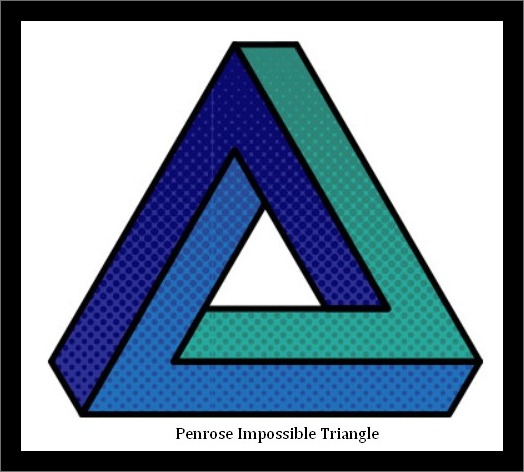
Through a connection the elder Penrose got it published in The British Journal of Psychology in 1958. The Penroses sent Escher a copy of the article, thanking him for inspiring the topic, that his artwork had been the muse and the genesis of the paper.
Two years later in a letter to his son, Escher wrote that he was…
|
…working on the design of a new picture, which featured a flight of stairs which only ever ascended or descended, depending on how you saw it. [The stairs] form a closed, circular construction, rather like a snake biting its own tail. And yet they can be drawn in correct perspective: each step higher (or lower) than the previous one. [...] I discovered the principle in an article which was sent to me, and in which I myself was named as the maker of various 'impossible objects'. But I was not familiar with the continuous steps of which the author had included a clear, if perfunctory, sketch, although I was employing some of his other examples. |
In March of 1960 Escher completed Ascending and Descending
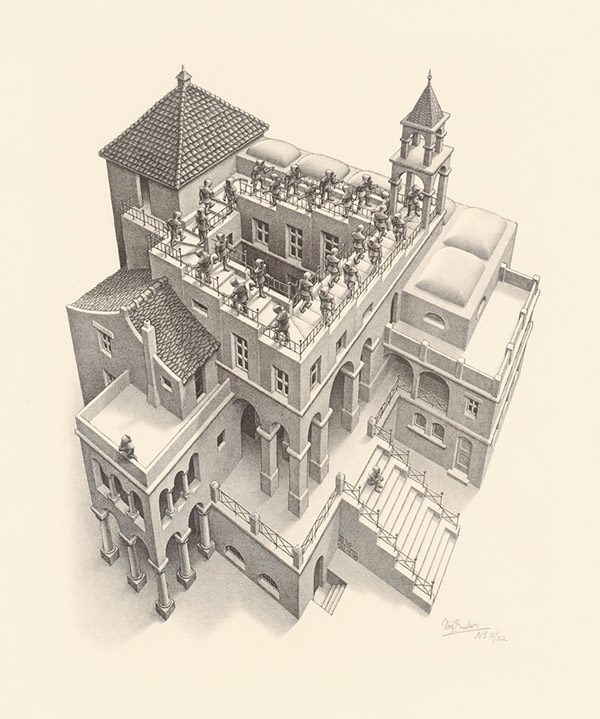
In a turnaround of the Penroses’ letter to Escher, he then wrote to the Penroses, thanking them for the inspiration to create Ascending and Descending, and sent them an original of the artwork. Imagine what they could have created together if they’d had connectivity, email, and digital co-creation tools as we enjoy today.
Since the advent of the personal computer and specialized software for just about every need, desire, and area of pursuit, it is now possible for the development of Digital Art. This can be individual on the part of the artist, or collaborative.
In some cases artists and mathematicians have been able to cooperate and collaborate, regardless of geography, time zones, or language barriers. Connectivity and digital tools of creation make this possible.
Fractals, or Fractal Art, is a perfect example of this. Not only is this entirely possible, but there are numerous free, open source programs available for people to download and use to create their own fractal art.
What is fractal? Or, “are fractals?” What does “fractal” mean? Dictionary.com describes it as a noun, a figure or surface generated by successive subdivisions of a simpler polygon or polyhedron, according to some iterative process. Wikipedia describes Fractal Art as a form of algorithmic art created by calculating fractal objects and representing the calculation results as still images, animations, and media. Fractal art developed from the mid-1980s onwards.https://en.wikipedia.org/wiki/Fractal_art - cite_note-fgad-2 It is a genre of computer art and digital art which are part of new media art. The mathematical beauty of fractals lies at the intersection of generative art and computer art. They combine to produce a type of abstract art.
These are examples of fractal images, all created via computer:

Would you like to create a fractal image? You really can do it. Want the tools to make it happen? Here’s how to get them: go to the TechNorms page, Wish to Create Fractals? There you have a choice of seven free tools to download to generate your own fractals. In the space of an hour, download, install, follow the directions, and POOF! You can be a Fractal Artist.
Point of note: on that TechNorms page there are seven fractal creation tools to choose from. Software is an individual, personal, intuitive experience. The software that Person A immediately groks and can just use like an old pro after mere minutes might just be impossible for Person B. Yet Person B installs and uses a different software program, groks it, uses it as though they were born with the knowledge and ability to do so, while Person A perceives that software as the most difficult thing to do or follow. Don’t be daunted if one doesn’t work for you. Just try another one! One more thing: Fractals are fun!
The celebration of Software and the Arts has gone from discussion and theory to practice among artists, and tech people. It’s become a community, even a movement. Art has had movements, just as music has. Perhaps this is better characterized a genre than a movement. Digital artists of many kinds are emerging. Some were tech types, some were artists, some were both. The convergence of art and tech, just as was the case of math and art, is a natural, organic, even evolutionary process. Digital assimilation and synthesis, occurs in nearly all aspects of life, including the arts.
Nine years ago New York serial entrepreneur Isabel Walcott Draves began hosting monthly salons. She called it LISA, for Leaders in Software and Art, a society of creative thinkers, developed to bring together people who work at the intersection of art and technology. The idea was to introduce membership to creative endeavors involving software and electronics. Members of LISA include software artists, digital artists, DIY (Do It Yourself) techies, fashion designers, patrons of the music and arts and other curators or producers of art and art collectors, technology entrepreneurs and VCs.
These monthly salons also had three or four digital artists each showing their work, then having a question and answer session afterward. This was (and still is) wonderful for networking or just getting to know people in the same or different fields, or to join in or listen to discussions about creativity and technology on a level not usually found in common fare. Isabel Walcott Draves has also taken LISA on the road, to Miami and Silicon Valley.
Out of the ongoing success of the monthly LISA salons grew a week long annual event, Creative Teck Week in New York. Spread across a variety of venues, the week features learning tracks, how-to participatory sessions, plus Virtual Reality product and development tracks from the creative to the technical ad everything in between.
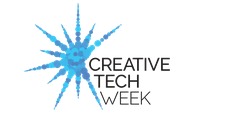
The Creative Tech week website says its community represents the extraordinary vanguard of commercial and artistic creative technology in the realms of industry, entertainment, education and the arts. Over a 10-day period, New York City becomes a showcase for creative initiatives using cutting-edge technology as a medium. In dozens of venues around the city, hundreds of experts host panels, performances, exhibits and parties.
To get to know more about Isabel Walcott Draves, how and why she began LISA and more about Creative Tech Week, check out this video interview with her at New Media Intersections.
A long time ago cavemen drew on the walls of their caves. They managed to capture what we now consider history. With digital tools at our disposal we can create artifacts that capture the moment and may at some point in the future be seen as our history. Or maybe you’ll click on one of those “how to make your own Fractal Art” downloads, and end up being part of next year’s Creative Tech Week.









